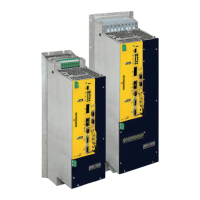
Do you have a question about the Baumuller b maXX 5500 and is the answer not in the manual?
| Protection Class | IP20 |
|---|---|
| Switching Frequency | 4/8 kHz |
| Current Controller Cycle | 62.5 µs |
| Interfaces | EtherCAT, CANopen, PROFINET |
| Safety | STO (Safe Torque Off) |
| Control Modes | Torque, speed, position |
| Feedback System | Resolver, SinCos encoder, EnDAT |
| Series | b maXX 5000 |
Specifies that devices are conceived for intended use only and outlines conditions for compliant usage.
Details risks like earth current, stored electric charge, EM fields, burn injuries, and radiated emissions.
Outlines the proprietor's duty to comply with safety regulations and ensure safe operation.
Defines qualifications for operating personnel and qualified personnel for safe device handling.
Lists required personal protective equipment such as clothing, hard hat, safety shoes, gloves, and eyewear.
Identifies risks related to electrical current, residual energy, moving components, and fire hazards.
Outlines preventive measures and actions to take in case of danger or accidents.
Specifies environmental conditions, supply system requirements, and motor requirements for optimal operation.
Details requirements for supply systems, inductance, power supply impedance, voltage, and frequency.
Describes requirements for three-phase motors, including voltage and DC link voltage compatibility.
Lists environmental conditions like temperature, humidity, altitude, and pollution degree for proper operation.
Provides data on cooling air temperature, water temperature, flow rate, and pressure requirements.
Presents detailed electrical data for various universal units and acceleration units.
Provides electrical specifications for different power module series, including input and output data.
Explains output current derating based on static output frequency below 15 Hz.
Describes maximum current limitations and PWM frequency reduction for BM56XX devices below 10 Hz.
Identifies and explains the function of display elements like interfaces, LEDs, and address switches.
Provides instructions on setting the IP address using address switches for EtherCAT® and POWERLINK®.
Highlights hazards related to unauthorized transport and mechanical impact during handling.
Emphasizes that mounting should only be performed by qualified personnel with adequate safety knowledge.
Details preparation steps including determining drill holes and avoiding conductive contamination.
Details different mounting methods, required components, and connection steps.
Stresses that installation must be performed by qualified personnel with specific training and authorization.
States that voltage testing is performed by Baumüller and requires disconnection during high-voltage testing.
Highlights the importance of meeting power supply requirements to avoid malfunctions or device destruction.
Addresses leakage current considerations and the requirement for Type B RCDs or alternative protective measures.
Discusses factors affecting RFI emission and the responsibility for EMC compliance.
Provides a step-by-step guide for installing the device, including cable connections and component installation.
Presents connection diagrams for electrical mains, motor, and controller connections.
Shows connection diagrams for basic units and power modules without controller connections.
Describes controller terminals, including digital inputs/outputs, fieldbus connections, and encoder interfaces.
Explains EtherCAT® fieldbus connection, including type codes, RJ45 pin assignments, and communication settings.
Describes VARAN fieldbus connection, including type codes, RJ45 pin assignments, and communication parameters.
Details CANopen® fieldbus connection, including type codes, RJ45 pin assignments, and memory/baud rates.
Explains POWERLINK® fieldbus connection, including type codes, RJ45 pin assignments, and communication parameters.
Describes the operating concept, including parameterization and the use of pulse enable and quick stop signals.
Explains the pulse enable and quick stop signals, their voltage levels, and terminal connections.
Details the DC link charging process, including the effects of different charging circuits and capacitance.
Explains how the controller unit monitors the device for deviations and reports warnings or error messages.
Describes communication via different fieldbus systems like EtherCAT®, VARAN, CANopen®, and POWERLINK®.
Highlights safety precautions for maintenance, including electrical hazards and workspace conditions.
Details monitoring functions, warnings, errors, and adjustable parameters for various device states.
Explains how faults are detected via LEDs and the 7-segment display, including error codes.
Describes error acknowledgment methods and predefined error reactions, emphasizing safety-related limitations.
Emphasizes electrical safety during shutdown and refers to transport and packaging guidelines.
Highlights safety precautions regarding electrical hazards and improper disposal of electronic components.